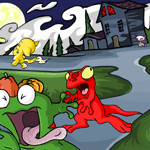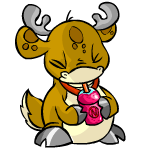 Our Friend the Neopoint
by parmadur
--------
A shrill scream pierced the night sky. A mouse clattered to the floor. Neopians
imagined they even heard the booming laugh of Dr. Sloth himself as they read the
horrific news. On Friday night, the 31st of the Month of Running, Year 8 many
Neopians gasped in horror as they read on the News page something they thought
couldn’t possibly happen. “With the NeoCharge system,” the official notice announced,
“a surcharge will be assessed for performing various activities on the Neopets.com
website.” The announcement, which Neopia later found out (to its relief) was an
April Fools Day prank, continued by explaining that “with inflation climbing higher
every day,” the Neopets Staff needed to take immediate action to protect the value
of the Neopoint and secure Life, Liberty, and Happiness for all Neopians. (Well,
maybe they didn’t go quite that far.)
“Before the NeoCharge system,” the notice continued, “Neopoints entered the
Neopian economy at a rate that was approximately 400% greater than the rate
at which they left the economy!” Oh no! Many innocent Neopians fell for this
“joke” for one simple reason – they weren’t aware of the principles of basic
economics.
Many Neopets (and sometimes their owners) consider economics to be one of the
more tedious subjects in Neoschool. However, those who have gotten past its
mysterious use of strange words like “marginal utility” and “elasticity” have
learned something important: economics is the science of how to make money.
Once people understand how the economy works they make more money, make it faster,
and most importantly don’t fall for pranks based on economics. Do you want to
be one of educated Neopians? Then read on.
Economics deals with the economy, (note that the two words sound very similar),
and the economy deals mostly with money. In Neopia, the first basic economic
rule is this: Neopoints are your friends. Economics teaches people how to make
money, and how best to use that money once you’ve made it. Because of this,
it’s important to start off by learning what money is and why it’s there. And
no, the correct answers aren’t “that yellow round shiny stuff” and “so you can
show everyone how cool you are.” Imagine for a moment that money doesn’t exist.
People trade items to get everything they need. Unfortunately for you, you don’t
have anything in your inventory. (How sad.) But wait! Now imagine that you find
a Pink Paint Brush. (Yay! Lucky you!) Unfortunately, your Grarrl doesn’t like
the color pink – he’d much rather be painted Electric. So how do you get an
Electric Blue Paint Brush? First, you’d have to find out how much your Pink
Paint Brush is worth compared to an Electric Blue one. Let’s pretend some more:
you somehow find three people who have Electric Blue Paint Brushes and want
to trade. Any of them would be delighted to give you their Electric Blue Paint
Brush for your Pink one, plus some extra items! One person offers (in addition
to the Electric Blue Paint Brush) ten Codestones and a Rainbow Paint Brush;
another person offers two Fyora Print Beds, and the last person offers three
jars of his Grandma’s unique homemade blackberry jam. Oh boy. Now you have an
even bigger dilemma. To find out which of these is the best deal, you have to
find out how many Codestones, Rainbow Paint Brushes, Fyora Print Beds, or jars
of blackberry jam your Paint Brush is worth. That means you have to find people
who would be willing to pay in only Codestones, only Rainbow Paint Brushes,
only Fyora Print Beds, or only blackberry jam for your Pink Paint Brush. As
you might imagine, life could get really complicated really fast. That’s why
the all-knowing Neopets Team gave us the Neopoint.
Here’s an interesting fact: Neopoints aren’t really worth anything. And no,
just because I say that doesn’t mean I’ll give you all of mine. Here’s the basic
idea: if you were marooned on Krawk Island, your millions of Neopoints wouldn’t
do you any good. Why? Krawk Island residents use Dubloons, not Neopoints, for
currency. What if all Neopians suddenly started to use Dubloons? Let’s hope
they don’t, because then our Neopoints would all be worthless. You can’t eat
Neopoints, you can’t wear them, and no matter how many you throw at your Neopet
while he’s in the Rainbow Pool, he won’t be painted Gold. Sorry. The only reason
people want Neopoints is because they’ve been arbitrarily chosen as the monetary
units of Neopia. In other words, people want Neopoints only because Neopoints
are money. And with money, you can buy anything that’s for sale. If everyone
has agreed to use a particular currency, whether it’s Dubloons, Neopoints, or
pretty shells, then that currency has value and becomes desirable to everyone.
But how does money work? Why does a Pink Paint Brush cost a million Neopoints,
while a Tiki Tack Keyring only costs one? There’s a simple answer to that: the
Law of Supply and Demand. Economics, like Neopia, uses laws to govern people.
Unlike Neopia, however, economics doesn’t require monitors to make sure the
rules are being followed. Everyone obeys the Law of Supply and Demand, just
because it doesn’t make sense to do anything else! So what is this law? The
basic idea is pretty simple. People pay more for rare items, and less for common
items. If there’s lots of something, (a big “supply” of that item), then it
will cost less. If lots of people want something, (a big “demand” for that item),
that thing will cost more. For example, everyone can get a free Jelly or Omelette
every day, so they only cost five or ten Neopoints. Items like Paint Brushes,
which aren’t very common and disappear after you use them, are much more expensive.
If Neopets gave every user a Paint Brush every day, there would be a huge supply
of Paint Brushes in Neopia. Nobody would want to spend a million Neopoints to
buy one. In fact, nobody would even be able to sell a Paint Brush for a hundred
thousand Neopoints, just like nobody right now could sell a Plain Omelette for
that sum. Let’s look at another example. Normally, you can buy an Icy Eye Snowball
for about 150 to 200 Neopoints. But every time a war starts, the price skyrockets
to 250 or 300 Neopoints each! The supply of snowballs hasn’t changed, but now
everybody wants them so they can go kill the evil (insert the name of current
villains here). There’s a higher “demand” for snowballs during a war, and so
the price goes up.
Economists use a nice little graph to illustrate this point. It looks like
a capital X. The line that goes from the bottom left to the upper right, (this
one: /), is called the “supply curve”. (Yes, it’s called a curve even though
it looks like a straight line.) The line that goes from the top left to the
bottom right (the one that looks like this: \) is called the “demand curve”.
The y-axis on this graph is “price” and the x-axis is “quantity”. This means
that when the Price of an item goes up, Supply goes up and Demand goes down.
This makes sense logically. If one hundred people each find an Electric Blue
Paint Brush lying on the ground, maybe one or two of them would be willing to
sell theirs for fifty thousand Neopoints, but crowds of people would love to
buy one for that amazing price. Maybe ten would sell it for a hundred thousand,
and they would still find lots of users happy to get a brush for that cheap.
About seventy or eighty of the hundred would be happy to sell the paintbrush
for 300K, (its current price), and they would probably find enough Neopians
willing to pay just about that much. And probably each of those lucky hundred
people would love to sell his Paint Brush if he was offered five million Neopoints
for it. But how many people would be willing to pay five million Neopoints for
an Electric Blue Paint Brush? Not any.
The place where the demand and supply curves meet is called the “market price”.
People are both happy to buy and happy to sell an item at the market price.
In the case of the Electric Blue Paint Brush, the market price is about 300,000
Neopoints. If people charge more than the market price, their items won’t sell.
If they charge less than the market price, they’ll miss out on profit they could
have made.
Now that we know about how buying and selling works, let’s see what happens
when there’s either too much or too little money in the economy. Now some people
might say that there can never be too much money. After all, the more money
there is, the more money everyone has! And the more money everyone has, the
more stuff they can buy. Right? Wrong. Imagine that every day Neopets gave you
one million Neopoints. Wow! Cool! Pirate Captain’s Cutlass ahoy! Now imagine
that every day Neopets gave everyone one million Neopoints. That wouldn’t be
so cool. Prices would shoot up faster than people could refresh their browsers.
Why? Let’s take a look.
Right now, a Faerie Paint Brush costs approximately one and a half million
Neopoints. Now, if you got a million Neopoints every single day, it would only
take two days to get more than enough Neopoints to buy that brush. Unfortunately
for you, the owner of that Faerie Paint Brush wouldn’t want to sell her valuable
possession for the amount of Neopoints she could get in just two days. So what
would happen? She would raise the price. Most likely, she would initially multiply
the current price, (1.5 million Neopoints), by one million, to offset the increased
number of Neopoints pouring into Neopia. In fact, she would have to raise her
prices every day to get the best value for her item. The same thing would happen
with every other good in Neopia. Even Omelettes and Jellies would probably be
priced at least at a million Neopoints. This “too much money-ness” is called
“inflation”. Currently, Neopian inflation is at 2.31%. This means that a thousand
Neopoints can buy something now that will cost 1,023 Neopoints next year.
The opposite of inflation is “deflation”. This is more rare, but has just as
big an effect on an economy. Imagine that suddenly half the games in Neopia
were sent to the Game Graveyard. (Horror!) You’d expect, logically, that Neopians
would now only earn about half as many Neopoints each day. What would this do
to prices? If they went up when inflation happened, it follows logically that
deflation makes them go down. And this is precisely what happens. Let’s imagine
for a moment that before the tragic loss of half of Neopia’s games it took the
average Neopian about a year to earn a million and a half Neopoints. Now let’s
take another look at that Faerie Paint Brush from the previous paragraph. At
its original price, it would now take someone two years to earn that Paint Brush.
The seller would be very happy about this if she didn’t understand economics:
after all, the amount of Neopoints she’d get from the sale would now be worth
twice as much! But as you now know, (don’t you feel smart?) if (on average)
people are only willing to pay a year’s worth of Neopoints for a Faerie Paint
Brush, anything more than that would be over the market price. The seller would
have to reduce her price for the Faerie Paint Brush by about half, or it would
never sell.
So why do you need to know this? After all, not very many people go around
finding Paint Brushes on the floor. (And as you have found out, that means there’s
not a very big supply!) The answer has to do with three words: saving versus
spending. Inflation encourages people to spend. Deflation encourages people
to save. Why? Think about it logically. If inflation is happening, what will
prices do over time? They’ll go up. If you keep all your money in a safe under
your bed, it’ll be worth less over time. (The money, that is. Not the safe.)
A thousand Neopoints right now can buy the same item 977 Neopoints bought last
year. The year before that, it would have only cost 955 Neopoints. Next year,
you’ll need 1023 Neopoints to buy that same item. If you kept all your money
in that dusty safe under your bed, your savings would just keep on shrinking
at a rate of 2.31 percent per year.
Similarly, if an economy is experiencing deflation, it encourages people to
save. After all, why would you want to buy that rare item now, when it will
cost less next year? You wouldn’t. In this case, keeping your money under your
bed would make it be worth more, not less, over time. But if you were going
to do that, a better place to keep it would be in the Neopian Bank. After all,
the bank pays you every day for letting them store your money! And remember:
only the National Neopian bank can keep your Neopoints safe from marauding Meepits
or ravenous rabid Rukis. (Hey, it could happen!)
Now that you know the basics of economics, you won’t be fooled by those who
insist that everyone would be happier if they were allowed to send games scores
five times instead of three. Your understanding of market prices will refute
the alarmist who whispers that all the Shopkeepers are part of a giant conspiracy
to keep prices high. You’ll be able to immediately detect economics pranks.
(In the instance of the April Fools Day prank, since we already knew that the
inflation rate was 2.31%, the 400% growth in the money supply was actually a
good thing!) Most importantly, the next time your Neopets whine that economics
is boring and pointless you’ll know to remind them that economics is the science
of making Neopoints. And Neopoints are every Neopian’s friend.
| |
|
Search the Neopian Times
Great stories!
---------
 Jobs You Should Never Do Jobs You Should Never Do
Trying to look at the classifieds of the Neopian Times trying to find a suitable
job to support your Neopets with no luck? Well, here are some jobs you should
NOT try to find simply because it will be pointless in the end...
by pikachu_tamer |
---------
 Twenty Terrifying Items of which to Beware Twenty Terrifying Items of which to Beware
Do you and your pets enjoy taking frightening voyages into the Haunted Woods?
Are you fascinated by terrifying items? Do you want to explode every time you
come across a cute, cuddly Snowbunny? If so, then you have come to the right article...
by lassie_nikki |
---------
 16 Summer Treats 16 Summer Treats
These beautiful blissful days are very near to us, so how about we plan for
the future? Well it is the Month of Eating, so how about we get this picnic
planned...
by lady_wart |
---------
|
|